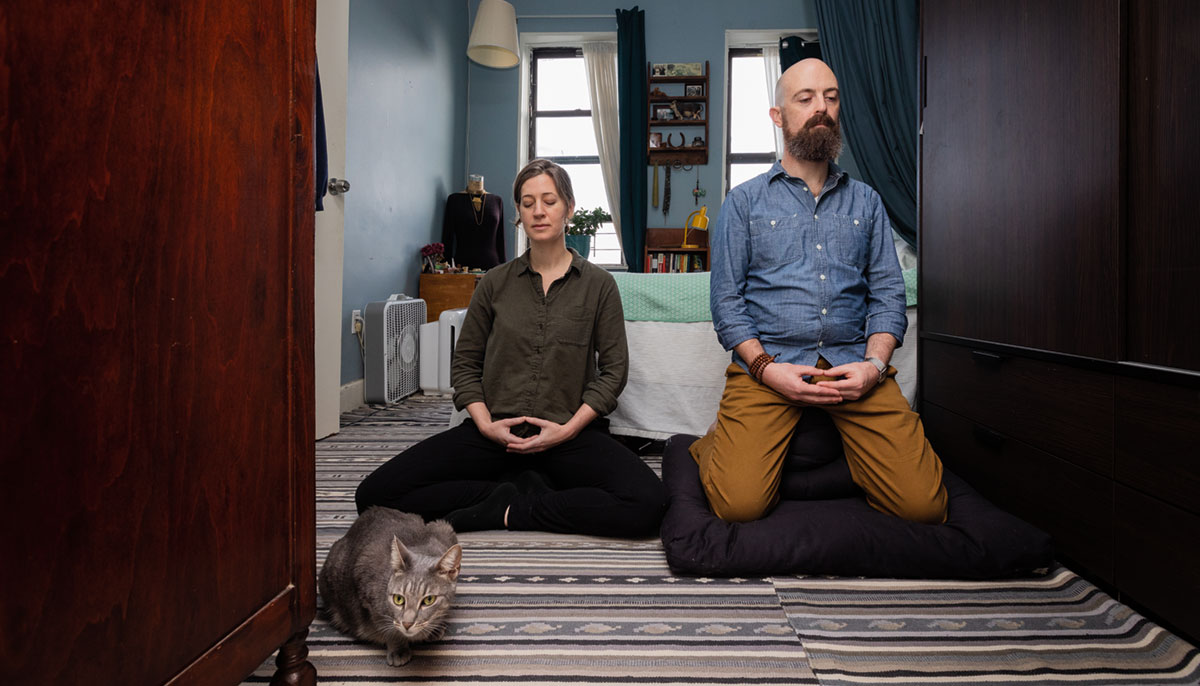The moment my meditation habit was established for good was in a checkout line at Whole Foods.
It was in 2002, I was in my early twenties, and I was living in Austin, Texas. I worked for a small software company, where I was failing. I smoked pot every morning before I went to work, and at lunchtime I sat in my car and smoked up again. Then I walked across the street to Whole Foods to get lunch.
On this particular day, when a Whole Foods cashier changed my life, I’d been meditating for a few months. I knew I was fucking up my life, so I was looking for something that would help. I’d read some Zen books. I’d set myself a thirty-day daily meditation challenge and achieved it. And by grace, the Austin Zen Center moved into a house around the corner from mine.
It was hard to ignore a signal like that. I started to sit there occasionally, and I met a grouchy, incisive priest named Sozan. Sozan taught a meditation class in the county jail outside of Austin, and he needed somebody to drive him because he was blind. I went with him weekly and even, in my naive way, tried to contribute some instruction.
So I was involved with meditation and Zen, but my practice was not firmly established—until Cashier Day. That day, when my sandwich and I reached the end of the Whole Foods conveyer belt, I looked up at the cashier and knew right away that I’d seen him before—in jail. He was a slim white guy like me, about my age, but sun-worn. When I’d met him in the meditation class in prison I’d identified with him. So when I saw him at the cash register I recognized him immediately.
I said, “It’s great to see you here.”
He said, “Yeah, it’s great to see you too.”
He explained in a couple sentences, while he was ringing up my sandwich, that our class had helped him. He had almost gotten in a fight, but he remembered to stop and feel his breath, and that gave him enough self-control to walk away. If he hadn’t avoided that fight, I thought, he probably wouldn’t be standing here with me at the Whole Foods.
“I wanted you to know,” he said.
I said, “Thanks for telling me,” and swiped my credit card.
And that was that. After Cashier Day, I got serious about meditation. We need faith in order to practice, and my friend’s story suggested to me that meditation really worked.
It has worked for me. It has saved me from wasting my life on superficial, deluded shit. I still spend a large portion of my life on superficial deluded shit, but I don’t spend my whole life on it, and I believe that is a consequence of regular meditation.
The very first step to establishing a solid meditation practice is to have faith we can be liberated—if not complete liberation than at least freedom from some of our painful habitual patterns. Next comes the day-to-day job of putting that into practice. Here’s five ways you can reap the benefits of a regular meditation practice.
1. Do it the same way every time.
In a paper published by European Journal of Social Psychology, Phillippa Lally and Benjamin Gardner describe four ways to deliberately form a good habit: (1) decide to act, (2) act on that decision, (3) repeatedly, (4) in a way that associates certain cues with the behavior.
If we do the same thing in response to the same cue for a while, it becomes automatic. My cue for meditating is when my alarm goes off in the morning. I get up and meditate because that’s how I’ve responded before. I do it even when I don’t want to.
This suggests we should meditate at the same time every day, and we should repeat the same small rituals. Every time, sit in the same place and light a candle and incense on a little altar. These cues of time, place, sight, and smell all become associated with practice. Each time you repeat the sequence, you add a stone to your habit’s foundation.
2. Start small.
We know this works for many habits in life. If you go to the gym but turn around and leave right away, you’ve still maintained your habit of going to the gym. Make a promise you know you can keep, and work up from there. When you meditate the same way two mornings in a row, even if it’s for a short time, you’re already building a good habit.
3. Sit with people.
Without a doubt, I have a regular meditation practice because I sit with my partner. On weekday mornings we set the alarm for 7:30, and we get each other out of bed to sit together. It’s true that sometimes we stay up too late, or sleep through the alarm, or one of us has to leave early. But we never stray too far off track because one of us always pulls the other back.
So if you live with somebody, try to convince them to meditate with you. This is the year to do it: mindfulness is at peak trendiness. Don’t hesitate: hook them now!
If it can’t be somebody you live with, you can sit with a meditation buddy via video chat. Or you can meditate with a Buddhist group in your area. I find it very powerful to meditate in a space that’s specially devoted to practice. It looks right. It smells right. Everybody is there for the same reason I am. Sitting with a group regularly is a great support to your daily practice at home.
4. Don’t expect something special.
A lifetime of meditation is transformative. But when it comes to a single period of meditation, you win some, you lose some.
We don’t expect that the first time we try pull-ups we’ll do ten in a row. We don’t expect to understand French the first time we try. But many people expect that the first time they sit down and meditate they’ll achieve inner peace.
Meditation will often feel hard, and it is always unpredictable, but we must not be frustrated by this. After all, trying to meditate is meditation, and in that sense it’s very easy. If you sit down and try to interrupt your own daydreaming and try to be conscious of your presence in the room for half an hour, you will achieve something.
That said, meditation shouldn’t usually be unpleasant and frustrating.
5. Enjoy it!
Find a way to enjoy meditation so you’ll keep coming back. I suggest that you invest in your altar, your cushion, and everything you practice with at home. I like to spend money on Zen stuff so I’ll enjoy using it. On the altar I made with my partner, we have a handmade vase by a professional potter in our sangha. It’s beautiful. We have a cute ceramic bodhisattva that I like looking at, and thirty-dollars-a-box incense that smells nice. I have a good cushion that’s been with me for sixteen years. All this stuff makes me want to use it.
You don’t have to splurge on meditation gear if that’s not your style, but you should certainly keep your altar clean and use incense you like. Meditation should be aesthetically pleasurable.
It should also be physically pleasurable. When you sit down, search your senses for a sound or smell you enjoy, or some part of your body that feels good, and let a bit of your mind rest there. If sitting hurts, try different chairs or cushions. Ask a teacher for advice about your posture. Or, make slow walking your main practice instead. There’s plenty of discomfort and pain in practice, but it’s not supposed to be a grind. If it is, I predict a short meditation career for you. Adapt the practice to reduce your pain and make meditation sensual.
Avoid frustration. It’s too easy, when we catch ourselves daydreaming, to think we can stop it from happening again by getting angry and castigating ourselves. But that’s a ticket to burnout. So when you do interrupt a train of thought, be glad you accomplished that instead of being angry that you were lost. Even if the whole meditation period seems ruined—you only thought about your job for half an hour straight—nevertheless, you sat. Your habit’s strength and integrity are unharmed. Reward yourself with a pat on the back. Then you’ll look forward to that same sense of satisfaction the next time you sit.
Meditation doesn’t have to be boring, either. I think what’s boring is when we kill off a meditation period, when we do it just to get it over with. But using every technique and every ounce of willpower at my disposal to prevent daydreaming and consciously listen to my thoughts? That’s a challenge, and challenges are fun.
But, in my experience, just establishing the meditation habit is not enough. To transform our lives, we have to practice solidly and regularly. Plus, as I see it, we have to read Buddhist texts, practice with a community of people with the same intention, and work with teachers who can guide us away from dead ends and dangerous paths and keep us on the path of awakening.
In the end, we’ve got to share our practice with people. We can’t just achieve peace of mind and then sit there smiling and abandon the rest of the world to its sadness. The idea of individual practice doesn’t even make sense.
Consider me and the Whole Foods cashier. I had gone to the county jail and shared my practice with him and it affected his life. The next time we met, he shared his practice with me and it affected my life. And I keep the wheel going: I go to Sing Sing prison regularly with the Village Zendo’s meditation program there, and I share my practice with our prison sangha.
We’re always practicing together. When Buddha had his big awakening, he didn’t say, “Aha! I personally am awake!” He said, “I, the great Earth, and all beings are simultaneously awakened.” That’s what’s happening when we practice together.
Being a regular meditator is sharing the practice with others—with your friends, with your family, with your fellow travelers on the spiritual path, with everybody in the world.

